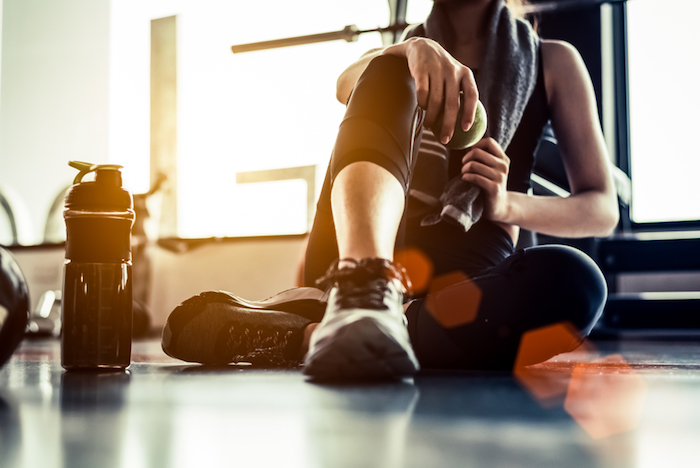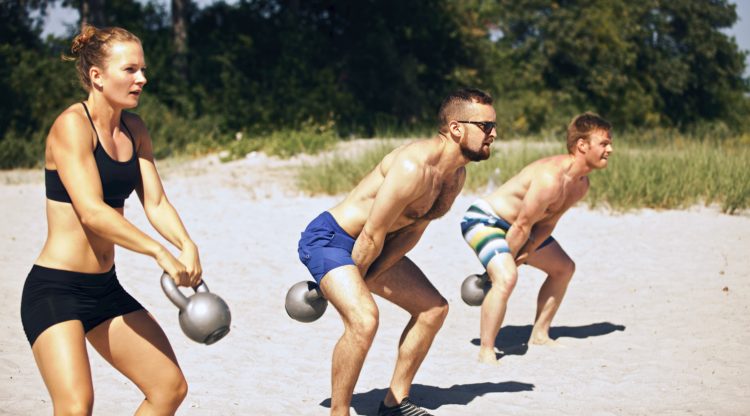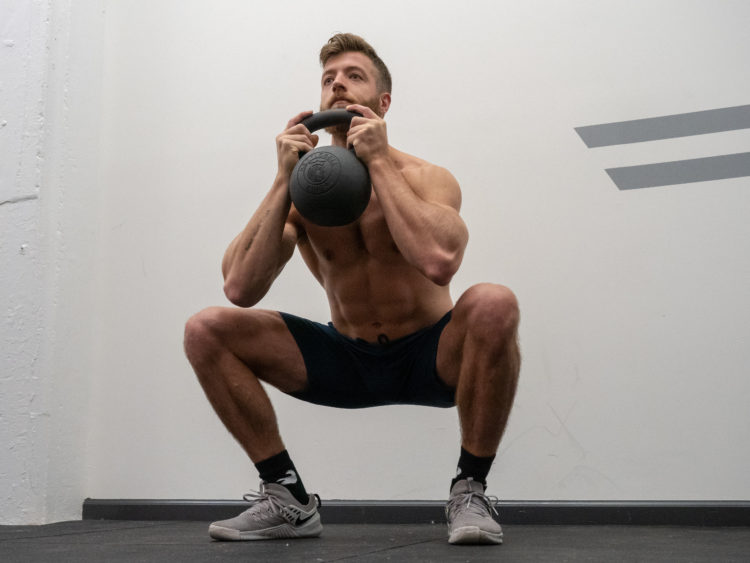If you’re like me, the idea of taking a day off from the gym is more painful than that soreness you get after some solid stiff-leg deadlifts. And on many days, even rest periods between sets get me antsy for more action. Enter active recovery: a magnificent way to boost your overall work capacity and stamina, improve your readiness for your next workout, and get to work on your weakest links and make them a powerful part of your repertoire.
And, as with anything, kettlebells are going to help you here. Because those little guys help with everything, seriously. Because they’re not only tools for low-to-no impact recovery: they’re also shaped in such a way that they can help you with some serious core stability and shoulder mobility work, which is something that pretty much everyone should be integrating into their recovery routine.
What Is Active Recovery?
Active recovery doesn’t just mean one thing: active recovery can take place in multiple setttings,
- During your workout in-between sets,
- In the cool down immediately following your workout, or
- On a specific day that you’ve devoted to the active rest and recharging of your muscles.
So sometimes, active recovery is an “active rest day” where you’re not lifting heavy, but you do want to get your blood flowing and get some tender stiffness out of your muscles. And other times, active recovery is integrated into your workout itself, either between sets or right after you’ve racked the last weight of the day.
[Related: 3 steps to building your own full body kettlebell flow]

The Science Supporting Active Recovery
No matter how you’re using active recovery, science is on your side to support the idea that it helps boost your performance. A lot.
If you’re using active recovery instead of passive resting (or phone scrolling, let’s be real) in between sets, you might be giving yourself a big performance boost. A 2019 study published in the Journal of Strength and Conditioning Research, for example, had 14 young adults (nine men and five women) in good physical health run a two-week control period.(1) Then, both groups ran four to six 30-second sprints with 4-minute recoveries in between. One group used that four minutes for passive recovery; the other group used that four minutes for active recovery, cycling at 40% of their V̇O2 peak. The group that trained using active recovery experienced better maximal power output rates, suggesting increased cardiovascular endurance for active recover-ers.
And even if you’re just doing your active recovery at the end of your workout, it still appears to help dramatically. A 2018 study published in Frontiers in Physiology looked at 26 trained men who were men, conducting 12 sessions of HIIT training over the course of four weeks.(2) Every participant had 15 minutes of recovery time after their workout: the group that used those 15 minutes for active recovery saw dramatically improved blood lactate removal. The active recovery group also raised their anaerobic lactate threshold. What does this mean? People who did active recovery work after training sessions could work harder and longer during subsequent training sessions, and could recover more efficiently in between them.

3 Ways to Use Kettlebell for Active Recovery
So why use kettlebells for active recovery? They’re going to challenge your body and push your conditioning and strength, but they’re going to offer little or no impact on your muscles, which means that your body can both challenge yourself and heal at the same time.
Active recovery isn’t just about improving conditioning and improving your body’s ability to remove lactate from your muscles. It’s also about targeting your weak points and making sure your body isn’t locking itself up in painful patterns while you’re not working out. And kettlebells are great tools for increasing mobility, both between workouts and during them.
Whatever method you choose for integrating kettlebells into your active recovery, you’re going to love the benefits. And hopefully, you’ll love the process, too.
[Related: 10 kettlebell exercises every athlete should master]
Method 1: Between Sets
At any given moment throughout your day — especially if you have a desk job — if someone randomly reminded you to relax your shoulders, it’s a pretty certain guarantee that you’d have to. Tension from stress and from sitting all day goes right to your traps and your hips, and even after you’re sufficiently warmed up, this tension can leak into your workouts and make your lifts suffer. Using kettlebells to improve your mobility between sets can translate into cleaner lifts and better form, whether you’re squatting, deadlifting, pressing, or even running.
15-15-15-15: 60 Seconds Active Recovery (Between Sets)
View this post on Instagram
Kettlebell Halo: 15 seconds one direction, 15 seconds opposite direction.
To improve blood flow to your traps and shoulders, as well as improve your mobility, between sets, stand with your shoulders relaxed. Engage your core and keep stable hips. Keep your chin up but not raised. Hold the handle of a light kettlebell in both hands and raise it to about chin level.
Trace the bell in a halo pattern around your head, using your arms rather than your neck or hips to help the movement along. The closer you can keep the bell on its travels to the base of your neck, the better for your shoulders. Travel fifteen seconds smoothly in one direction around your head, then transition to the traveling smoothly in the opposite direction.
View this post on Instagram
Kettlebell Slingshot: 15 seconds one direction, 15 seconds opposite direction.
To continue improving your shoulder mobility and engage your core to prepare for your next set, keep your shoulders back and stand tall. Engage your core and prepare for an adventure in improving your functional strength.
Keeping a slight bend in the knees and a vertical body, hold the bell handle loosely in one hand. In a slow, controlled way, use your core to guide the movement of the bell around your hips. When your hand with the bell reaches the end of its range of motion in front of your body, switch hands and continue the circle around your hips and behind your body your other hand. Once you’ve gotten a good flow for fifteen seconds, switch directions and repeat the movement for 15 more seconds.
Method 2: Right After Your Lifting Session
If you’re looking to spice up your cool down, use this kettlebell circuit to improve blood flow and start ridding your muscles of excess lactate. You’ll also be improving your conditioning such that you’ll be able to better kick ass in your next workout. Just make sure you’re using light bells: you’re not doing an entirely separate workout. You’re cooling down, actively. Your body will know the difference, so commit yourself to keeping it light.

Light Conditioning Circuit: 12 Minutes Immediately Post Workout
Alternating Kettlebell Swing: 60 seconds.
Remember that you’re using a light bell here. Remember, too, that the swing comes from your hips, not from yanking your arms. If you’ve just finishing a deadlifting session and you’re concerned about your back, feel free to replace 60 seconds of swings with 60 seconds of kettlebell cleans (30 seconds each side). But again, keep it light. You’re recovering, not adding huge volume to an already intense session.
Kettlebell Snatch: 30 seconds one side, 30 seconds opposite side.
The aim here is not to add poundage to your snatch: the aim is to get your whole body moving, making sure your blood is flowing and your heart is pumping. So breathe through it and focus on form.
Repeat circuit six times (12 minute total). Don’t forget to stretch, as well.
[Related: Why kettlebell swings benefit any type of athlete]
Method 3: An Entire Day For Active Recovery
For those days when you know your body needs a rest, but maybe not a full rest day — because remember, the advantages of active rest over passive rest are immense — active rest is going to be your best friend. Just make sure that when you’re getting your kettlebell active rest on, don’t be tempted to go all out with other things or make your movement longer and heavier: commit yourself to active rest, and your body will thank you.
Strength and Conditioning Circuit: 20 Minutes
Alternating Kettlebell Swing: 60 seconds.
Keep it light, and keep the motion coming from your hips. Make sure you’re breathing through it, and make sure your transitions are clean.
Turkish Get-Up: 30 seconds one side, 30 seconds opposite side.
This timing scheme won’t get you a lot of reps, but it’ll get you quality. You can go a little heavier here, since your movements will be so determined. Make sure your shoulder is always packed, and keep eye contact with the bell at all times. Breathe with each step of the movement, as always, and keep yourself concentrated on your core.
Two-handed Kettlebell Swing: 60 seconds.
You want to go back to keeping it light, now. You’re still focusing on blood flow, on making sure you’re getting quality reps. If you’re getting a little winded, that’s okay: rest if you need to, but only as needed. Try to keep with the circuit as much as you can. But remember that this active recovery is all about going light while training your body to be able to go harder, so listen to your body first and foremost.
Kettlebell Goblet Squat: 60 seconds.
If you’re more comfortable holding one bell for this, great: just keep it light, and keep your core tight. If you can, though, and you want to hold two bells in rack position throughout this part of the circuit, have at it. It’ll give an additional challenge to your core, not to mention to your legs. You’re not looking to add leg-day volume here, remember: keep it light enough that you know you can confidently keep it going for 60 seconds, squatting to full depth each time.
Take breathers as needed, and lower the weights if you started out too ego-heavy. That’s always okay.
Repeat circuit four times, for 20 minutes total.
And that’s it. Done for the day! You have actively recovered: well done.
[Learn more: A step by step guide to the goblet squat]
Wrapping It Up
So whenever you need to actively recover — between sets, after a session, or on its own dedicated day — kettlebells are there for you. You can use them to improve your mobility, increase strength, and make immense improvements to your conditioning with kettlebells, all while preparing your body to perform even better next time. Because active recovery with kettlebells is great for making sure you’ll come back stronger in your next workout, and that’s what we all want to do, isn’t it?
Featured image via Microgen/Shutterstock
References
1. Yamagishi T, et al. Active Recovery Induces Greater Endurance Adaptations When Performing Sprint Interval Training. J Strength Cond Res. 2019 Apr;33(4):922-930.
2. Wiewelhove T, et al. Active Recovery After High-Intensity Interval-Training Does Not Attenuate Training Adaptation. Front Physiol. 2018 Apr 18;9:415.
